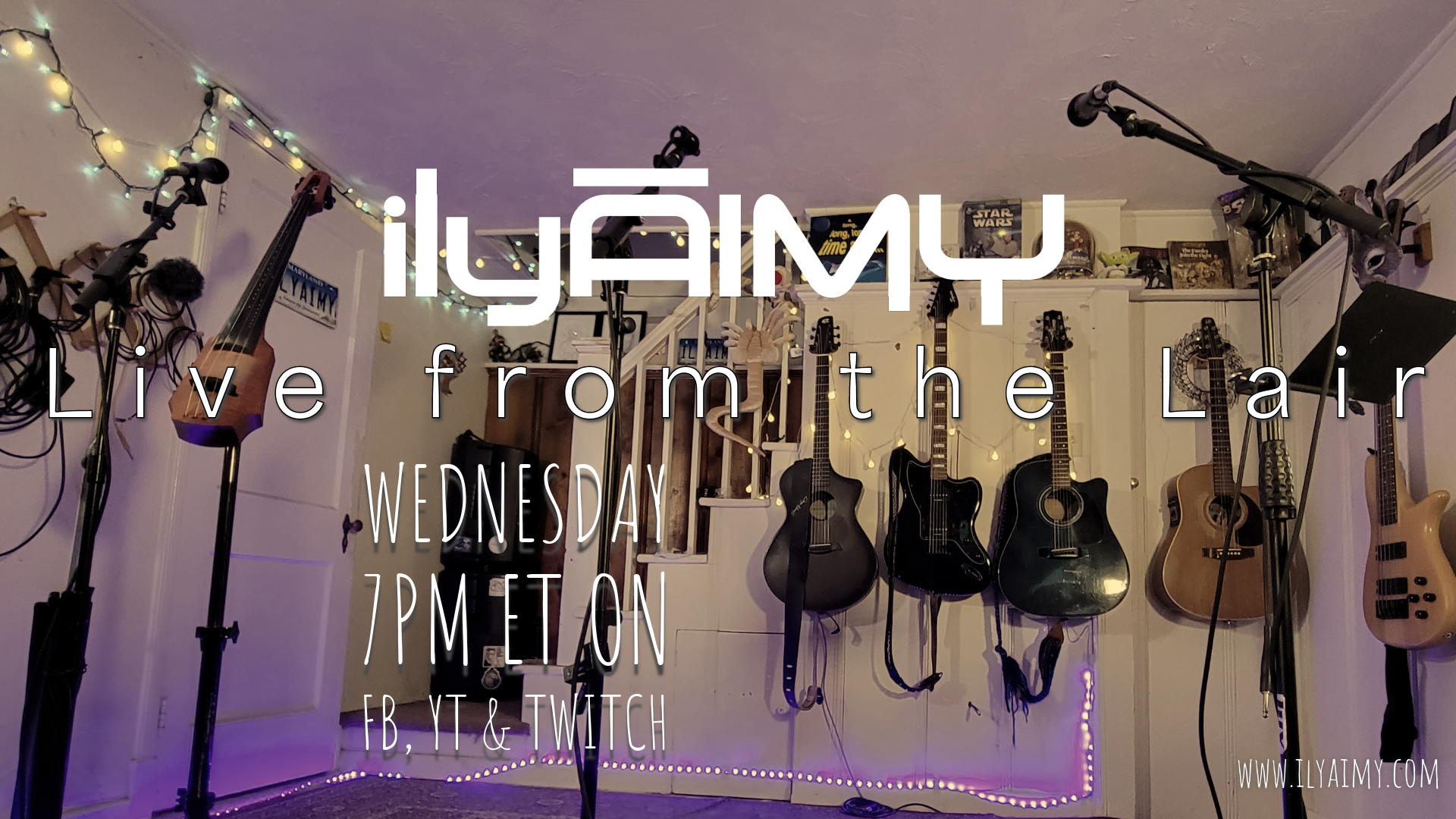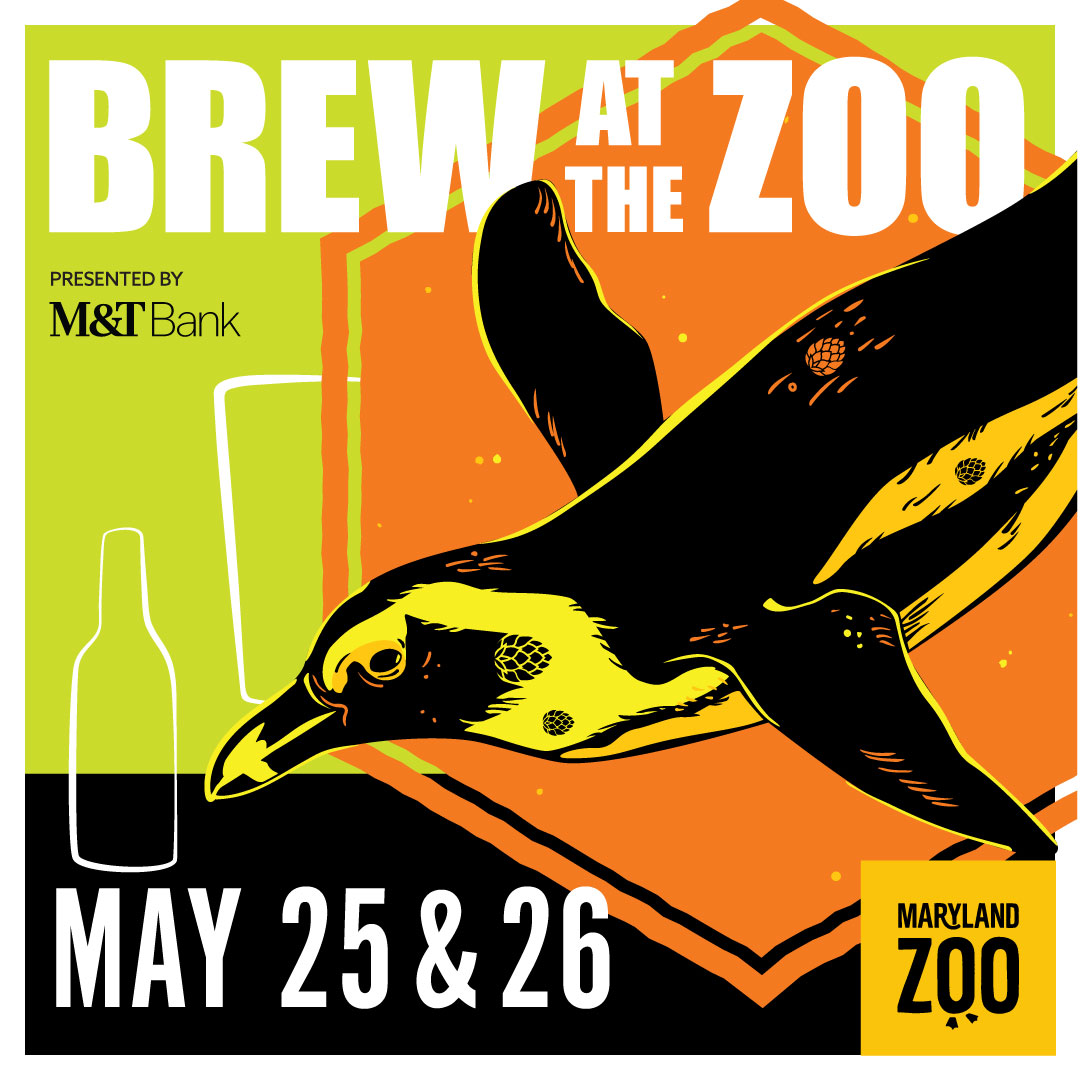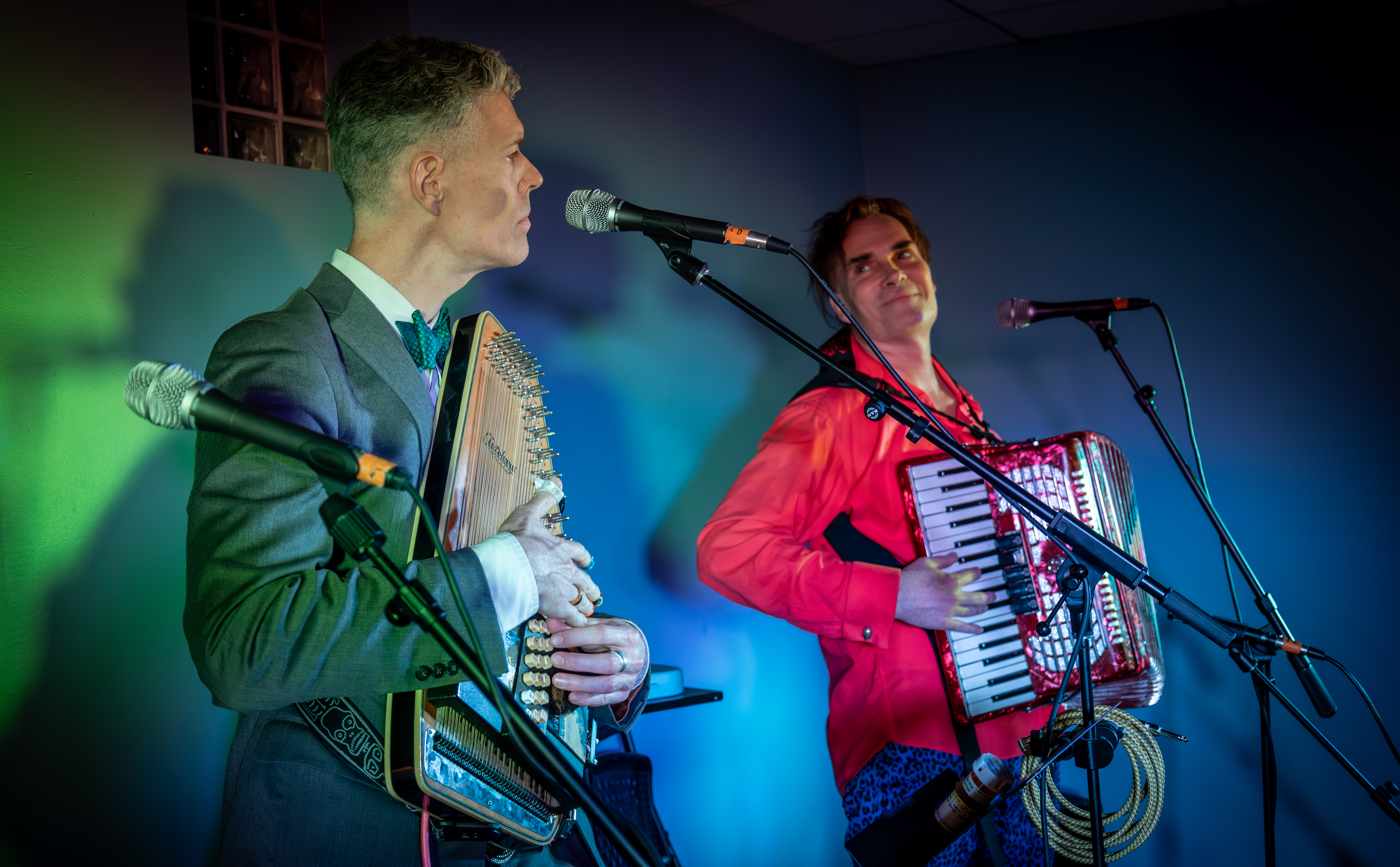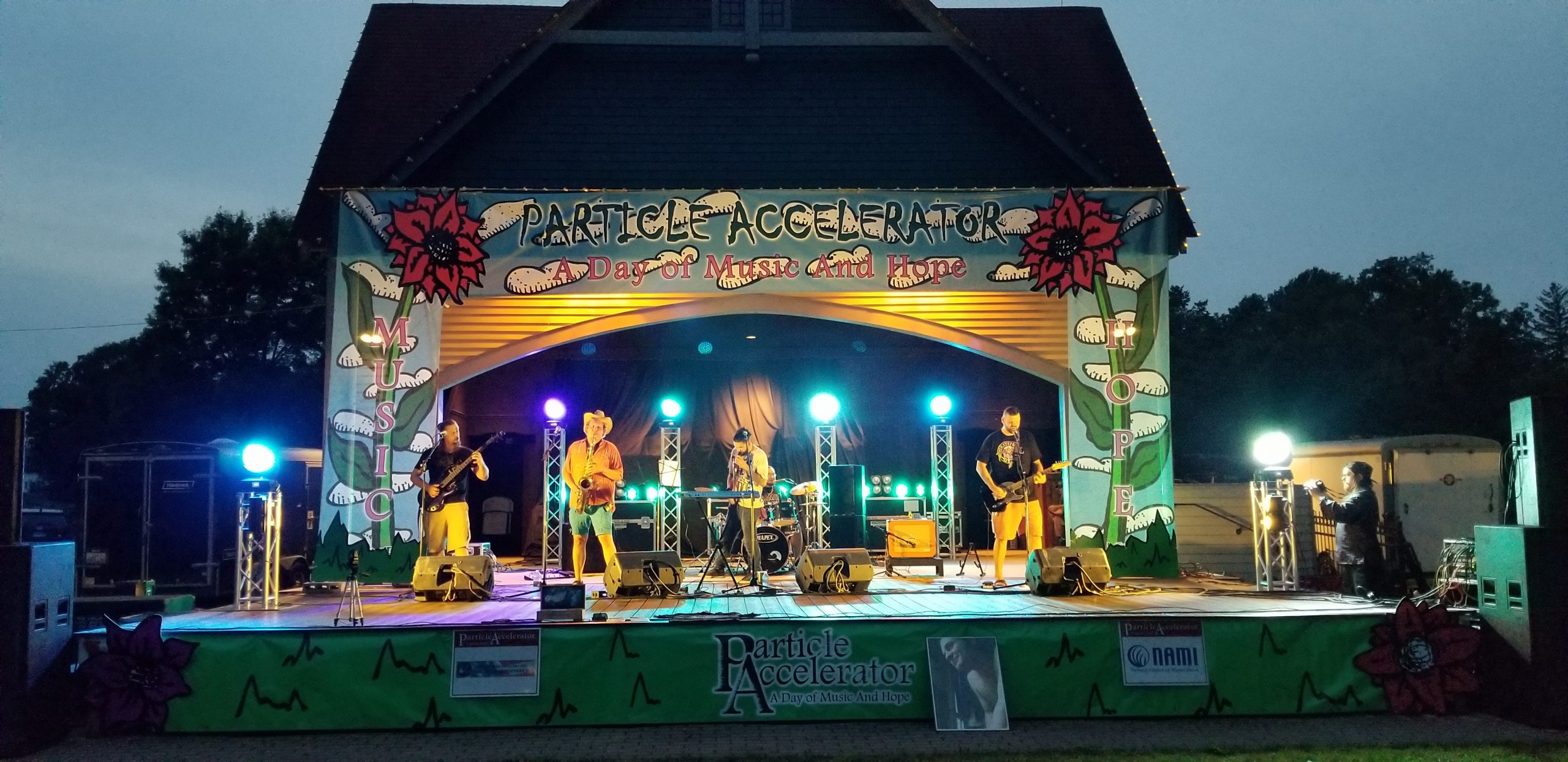
We rolled into Indianapolis and swung a few minutes out of our way to visit my tattoo artist, David, at a convention he was working. We stayed the hour-and-a-half we had after driving in three hours from Columbus, OH, long enough to watch a girl put herself through a tennis racket.
We headed over to the Irving Theatre, a place I’d played solo. It’s an old theatre with a transplanted stage I remember being told was the last one on which Elvis ever played. A more intimate performance area sits in front of that, with a chandelier of sorts I love. Hanging from the bare wooden rafters, natural crystalline-shaped iron frames hold lacquered Muncie, IN, newspaper shades, diffusing a sepia glow through the text. The owner tells me they were made by Ball State architecture students. Underneath it, the warm patch of light in the middle of the dark room illuminates a few old rugs, and the whole place looks like what MTV Unplugged copied its design from.


We find Ember Swift and Kelly Zullo, this time in percussion mode, soundchecking. (http://www.emberswift.com, http://www.kellyzullomusic.com). Memories of my time touring as Dar’s backing vocalist/percussionist … Slow it down a little, singing harmony lines to each other to mimic. There are days when that month-long adventure seems like another life. We know Kelly (who we met right here in Indy when all us out-of-towners shared the stage at Radio Radio) completely independently of Ember (who we opened for at Jammin Java in VA), and this night is a happy accidental confluence. Her guitar tone is stunning and round and stays with me for hours. Ember, who we have not seen in four years, is very pregnant, and angling her slick black Gretsch across her hip. I joke that there must be some female luthier who’s made a guitar and a 9-month rental business around this concept. She immediately starts searching the internet to see.
She and I have some downtime in the green room and catch up. Pregnant, she looks like some mischievous wood sprite, surprisingly lithe and ethereal. Despite the wild adventures of her own life during the last four years (she ended one major relationship, started another, moved from Canada to China, took a new musical direction, took a new sexually expressive direction, is having a baby), she remembers that we last encountered each other at Solarfest in Vermont, and that beneath the rafters of that cathedral-like barn we had a discussion about transition.

The transition we commune over is ending romantic relationships with our musical partners. She is surprisingly candid about her experience with that, and about what people think about it all. I understand all too well, though rob and I survived many years ago what destroys most bands. But fans still have questions and opinions about that. Yes, I put my personal life out there in song, but shielded in a lot of craft. Ember wears her heart right out there on her sleeve. People become interested. People wonder about things. I found myself doing it with a songwriter I met recently, imagining what a specific turn of a phrase or a collection of songs meant. And I also know I’m probably completely wrong in my suppositions.

I was asked only a couple months ago if my song, Letters From the Front, off The Fifth Circle, was my peace offering to rob’s new girlfriend, Kristen, telling her we were going to be okay. I didn’t mind explaining to the fan that the song was written our first year on tour in our friends’ Richmond home, many years before we would even know Kristen at all. In fact, it was about two men, with whom I was fighting for various reasons. And as always, it was about me, and my inability to deal with change and my frustration with myself. And for all its metaphor, it is one of the most literal songs I’ve ever composed. The pine cones, the razor blades, the Che Guevara t-shirt … all of these things were real.







So – I was thinking to myself the other night about how I could use as much parmesan cheese as I damned well pleased. Because I’m an adult. There ARE actually perks to being grown up – and they have a lot to do with being able to buy what toys you want when you want and eating stuff your parents said were too expensive to eat much of. Of course, in real-world terms this makes me financially kind of sad, but the other night when I was eating the best 2am spaghetti it was possible to have, in real LIFE terms I was incredibly wealthy. And then we go to Great Country Farms and we’re too old to jump on the big ass Jumping Pillow. Sigh.
I ask rob to verify a few of these facts, and he explains my own writing to me: “When you want to express something brutally honest or confessional in song, you build a construct around it. A framework that allows you to say something really personal and painful within a protective casing.” I’ll respond to just about any direct question about my songs. If you want to know, I’ll tell you. The odds are there’s a parfait of juicy details that will allow me to preserve whatever secret I feel they absolutely have to keep at the bottom.
Ember is completely open. A direct conduit from heart to hands. She is writing her own soundtrack.

As we were setting up for the show at Great Country Farms in Bluemont, VA we were asked to delay for a sec. Because we might scare the horses…. “Horses?” We asked? 


Horses. You know… the ones bringing the Pumpkin Princess! We were pretty overawed. I mean, the Suburu carried our gear proudly, but that’s a fucking horse-drawn pumpkin carriage!!!
Am I writing my own soundtrack? Certainly, when I look back on it later that is what it will be. I’m preserving feelings instead of pictures. And I can already see how I’ve been changing. The beginning is my journalistic background converted to express true stories about being ineffectual, afraid and self-deprecating; Matador, Pine, No Place is Home, Letters From the Front, Save Berlin, Sever, Simile Blue, I am The Wreckingball.


I was gonna swipe Kristen a pony, but then I remembered we’d brought the Suburu. Sigh. No trunk. 





The song In the Water marks a transition where, having decided on songwriting as my vocation, I start to employ some craft and tell stories that are not exclusively about me. Within a couple years, I’m concealing the personal inside crafted songs. I become enraptured with simply elegant songs, and try my hand at that for No Blue Left, which was still a painful raw wound of a song about moving on to the first new partner after a relationship ends. I started with a complex song and hacked it down with a machete to the shortest lines that would express my idea. I start collecting “types” of songs I admire. Like, “I want one of THOSE in my repertoire.” Ask for Me was the last song to go onto Cecilia, and I bumped Phantom off for it. I wanted to express something positive, longing and hopeful, because that’s where I was going.
The solo disc, Samples, released a year and four days ago, involved my most crafted songs, having been given an idea and a deadline for all of them. I stretched myself and went way beyond my habits both for topic and treatment. And it involved the first consistently happy time in my songwriting life. So there are love songs, and songs about personal triumph. Some transitioned within song … like Seat. It started as a gut-wrenching song about being abandoned (a construct hiding that truth about my own life), and I forcibly guided it into a triumphant ending. One that was aspirational more than being true at the time. Writing a song for what I wanted and not what was happening. That was a first, asking life to emulate art. When I finished it, I still didn’t know if I believed it. And the almost religious-rock For Your Sake was a song I absolutely did not want to write, but I’d promised I would. One of our biggest donors for Cecilia wanted a song written about the “Paradoxical Commandments” (http://www.paradoxicalcommandments.com) at a moment when I was finding it hard to believe in them. So I wrote what was for me a subversive answer to them. That I wasn’t sure if doing good in the world was worth a damn, but for this person who was good, I would do it anyway.
My ex recently wondered if I could do my best work if I was happy. I held up the disc and pointed to it.
So what now?
Some things haven’t changed. My frustration with myself has transitioned into a frustration with the world and a feeling that I am completely alienated from it.
Revolutions Per Minute and Oracle are the first political songs I’ve ever written. I’m experimenting with new tunings and trying to expand the use of my instrument, realizing that I am a songwriter who thinks about instrumentation too secondarily. My growing comfort with percussion makes me long to write songs that start there, too, and I’m starting to become more comfortable with ukulele. And I’m becoming obsessed with simplicity and the elegance that comes with restraint.

Kristen got the definitive shot of how we knew the people at Great Country Farms were just our kind. ” ilyAIMY played a 4-hr gig last Saturday at Great Country Farms in Bluemont, VA. Looking at their website pre-gig, we were really curious as to why the booking company picked US as “Family Friendly Entertainment” for this one. But it was a great experience. Great farm, great folks. If you have kids, it’s well worth the drive out to Bluemont to visit here. And it’s right across the road from Bluemont Vineyards if you need more adult activities. ” The rest of her gallery is here. 
Finally, I can be amongst my people. (At Great Country Farms in Bluemont, VA)
And my lovelorn nature is still there, so I’m writing very true songs about trying to figure out how to have emotions as they seem to be leaving me. The most recent song, I Didn’t Put it Down (http://www.youtube.com/watch?v=5Of6DHsSVLA), is a return to all things true … but also illustrates my songwriting blueprint if I have one, something I like to call the “three-vignette folk song.” Oklahoma Revival, For Your Sake, No Blue Left, Revolutions Per Minute, Oracle, and even the murder ballad all were born from this idea, which I’m sure someone else has come up with under a different name. You can follow along with these examples at http://www.sonicbids.com/ilyaimy.

My idea is that you can best develop a song concept in three vignettes, short, impressionistic scenes that focus on one moment or give a particular insight into a character, idea, or setting. The chorus becomes your thesis, the central idea that connects to all three vignettes while each of those scenes advances the idea a little further.
Let’s use Oklahoma Revival as an example. The central idea is this dust bowl farm couple having trouble in their marriage, who rekindle it during a storm. So we need to set the existing scene of their location and troubled state (vignette 1), then we need to put them into the situation that will change them (vignette 2), then we need to show that change has occurred (vignette 3). Meanwhile, the choruses need to reinforce the central idea, and contain some unifying metaphor. I decide on a technique I often employ in this format, exploring a word that has multiple meanings. Sand. I decide to make use of the noun and the verb. Same thing with “grain.” Having two words with wood connotations, I explore carpentry words, ideas and images, and lace the song with them. I word bank like other songwriters (I was delighted to find out Brian Gundersdorf from We’re About 9 did this also). I also have an affection for slant rhymes and slam poetry, and that style works its way into how I pace the lines.

My only bias when it comes to songwriting is that, whether it is personal or not, pop or progressive … there should always be something profound. Songwriting should speak to the listener, commune with them, but it should also find a moment where it shakes them to the core, makes them realize something secret, challenges them, or expresses something in such a special way unique to the writer’s perspective that the listener at once feels deeply understood and subversively broadened.
My favorite example of this recently is Anthony da Costa, my musician crush of the moment, who I’ve run into at Susie’s House Concert, Falcon Ridge and Tom Bianchi’s event at The Burren all in a few months:
In the song “St. Therese,” a pop framework that speaks to universal loneliness with a catchy hook uses a specific image to illustrate that idea: having only a record you’re not in the mood for available to listen to. He picks one that most people will know, references it in the beginning and then end of a song, and comes up with something that both makes complete sense and is utterly original: “loneliness is listening to the record that you’ve got/not the record you want.” I couldn’t have written it. He had to write it, but I understand it and it connects with my own experiences. This line, very intentionally, elevates the entire song.
A group of bikers so numerous passed the window outside Coffee Amici just now. They took a couple minutes to pass the coffee shop window entirely, like a migrating flock of birds welcoming the first day leather jackets could be worn comfortably. It is so very, finally Fall.


















